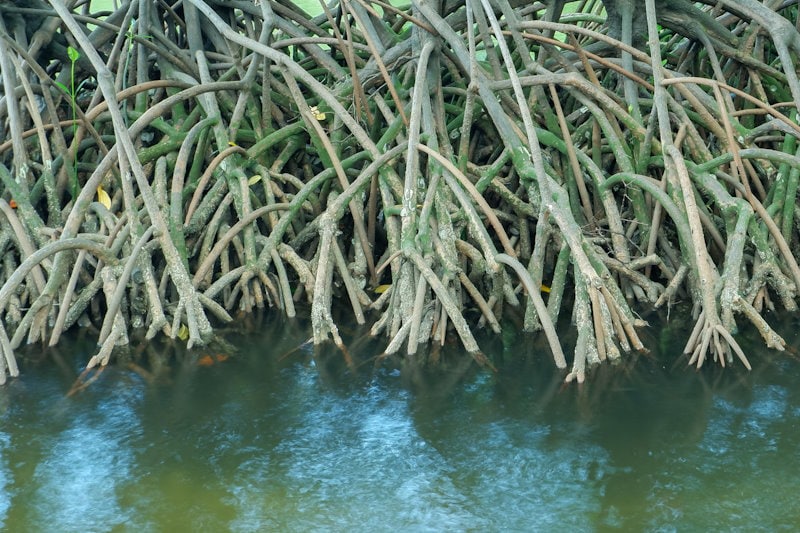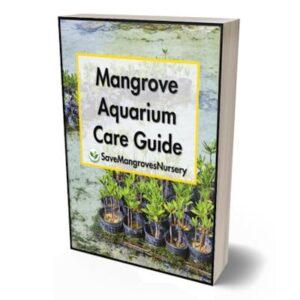
Mangrove plants are an incredible addition to any aquarium, bringing a touch of coastal charm and a host of benefits to your aquatic environment. However, as with any living plant, they require proper care and maintenance to thrive.
In this guide, we’ll explore some common maintenance problems you might encounter with your mangroves and how to avoid them.
By the end, you’ll have the knowledge to keep your mangroves healthy and flourishing.
Understanding Mangrove Basics
Before diving into the common problems, it’s important to understand the basics of mangrove care. Mangroves, particularly Red Mangroves (Rhizophora mangle), are unique in their ability to thrive in various water conditions, including saltwater, freshwater, and brackish environments. They are well-known for their intricate root systems, which help stabilize substrates and filter water.
🛑 Mangrove Fun Fact: Did you know that mangroves can store carbon up to five times more effectively than terrestrial trees? This makes them an eco-friendly choice for your aquarium!
Problem 1: Inadequate Lighting
Why It’s a Problem
Mangroves require plenty of light to photosynthesize and grow properly. Without sufficient lighting, they can become weak, lose their vibrant green color, and fail to thrive.
How to Avoid It
Ensure your mangroves receive at least 8-12 hours of light each day. If natural sunlight isn’t an option, invest in a high-quality LED or fluorescent aquarium light. Personally, I’ve found that using an LED light with an adjustable spectrum works wonders for mangroves, allowing me to mimic natural sunlight and promote healthy growth.
Good ✅: Use a full-spectrum LED light to mimic natural sunlight and support mangrove health.
Bad ❌: Relying on low-quality or insufficient lighting can stunt your mangroves’ growth and lead to health problems.
Problem 2: Poor Water Quality
Why It’s a Problem
Mangroves are highly effective at absorbing nutrients and filtering water, but poor water quality can still impact their health. High levels of nitrates, phosphates, or toxins can stress the plants and inhibit their ability to filter water. Maintaining the ideal water conditions for your mangrove plants is key to a healthy tank.
How to Avoid It
Regularly test your aquarium water to ensure it remains within the optimal range for mangroves. This includes maintaining a stable pH level, avoiding excessive nutrient build-up, and performing regular water changes. In my own aquarium, I make it a habit to test the water weekly, which has helped me catch potential issues before they become serious problems.
🛑 Mangrove Fun Fact: Mangroves can tolerate a wide range of salinity levels, but they thrive best in water with stable, moderate salinity.
Good ✅: Regular water testing and maintenance help prevent nutrient overload and maintain a healthy environment for your mangroves.
Bad ❌: Neglecting water quality can lead to nutrient deficiencies, algae overgrowth, and poor plant health.
Problem 3: Improper Substrate Support
Why It’s a Problem
Mangroves have extensive root systems that need a stable substrate to anchor into. If the substrate is too loose, too compacted, or lacking in essential nutrients, your mangroves may struggle to establish themselves.
How to Avoid It
Choose a fine-grain substrate that allows roots to penetrate easily while providing adequate support. In my experience, a mix of sand and fine gravel works well, offering the right balance of stability and permeability. Additionally, consider adding root tabs or other nutrient supplements to enrich the substrate.
Good ✅: A balanced substrate with added nutrients supports strong root development and overall plant health.
Bad ❌: Using a substrate that’s too compacted or nutrient-poor can hinder root growth and lead to weak, unhealthy plants.
Problem 4: Nutrient Deficiencies
Why It’s a Problem
Mangroves are heavy feeders, especially when young. Without access to essential nutrients like iron, magnesium, and potassium, they can suffer from stunted growth, yellowing leaves, and other signs of nutrient deficiency.
How to Avoid It
Supplement your mangroves’ diet with liquid fertilizers or root tabs specifically designed for aquarium plants. Be mindful of the dosage, as over-fertilizing can lead to other issues, such as algae blooms. I’ve found that a balanced, all-purpose liquid fertilizer works best, applied once a week during regular maintenance and water changes.
🛑 Mangrove Fun Fact: Mangroves are particularly efficient at extracting iron from their environment, which is crucial for photosynthesis and leaf development.
Good ✅: Regularly supplementing with aquarium-safe fertilizers helps ensure your mangroves get the nutrients they need to thrive.
Bad ❌: Ignoring nutrient needs can lead to yellowing leaves, weak growth, and increased susceptibility to pests and diseases.
Problem 5: Pests and Diseases
Why It’s a Problem
Like all plants, mangroves can fall victim to pests and diseases. Aphids, spider mites, and fungal infections are among the most common issues that can affect mangroves in an aquarium setting.
How to Avoid It
Maintain a clean environment and monitor your plants regularly for signs of pests or disease. If you spot an issue, act quickly—prune affected leaves, increase water circulation, and consider using natural pest control methods like introducing beneficial insects or using neem oil. I’ve had success with introducing small, pest-eating fish to keep my mangroves pest-free.
Good ✅: Regular monitoring and natural pest control methods keep your mangroves healthy without harming other tank inhabitants.
Bad ❌: Ignoring pests or diseases can lead to widespread damage and potentially kill your mangroves.
Mangroves are a unique and beneficial addition to any aquarium, but they do require proper care and attention. By avoiding these common maintenance problems—such as inadequate lighting, poor water quality, improper substrate support, nutrient deficiencies, and pest infestations—you can ensure your mangroves remain healthy and continue to enhance your aquatic environment.
How Do I Choose My Very First Plant?
So you have learned about the incredible benefits of adding mangrove plants to your tank, but you still don’t know which exact plant to add to your specific tank size?
Don’t worry, because we’ve created an easy Step-by-Step guide to help you with your selection process.
Click the button below to find out which plant is perfect for your aquarium.

 Cart is empty
Cart is empty 
